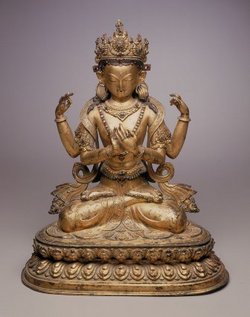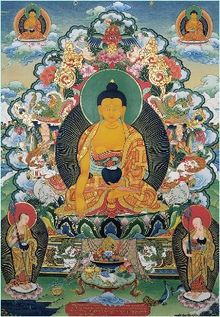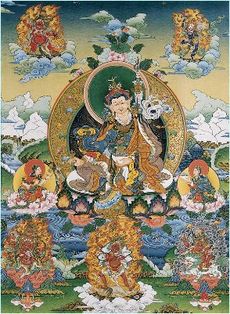|
|
| (174 intermediate revisions by 6 users not shown) |
| Line 1: |
Line 1: |
| == ''A Glossary of Buddhist People, Places, and Things...'' == | | <div style="top:+0.2em;font-size: 110%"> |
| ''- '''The Terms by which They're Defined''' -'' | | <center>'''~~ <span class=TibUni20>[[རང་བྱུང་ཡེ་ཤེས་ཕིབ་རྒྱ་དཀོན་མཆོག་ཕོ་བྲང་ཆོས་ཀྱི་ཕྲིན་ལས།]]</span> ~~'''</center></div> |
| | ---- |
| | <center>'''''~~ A Glossary of Buddhist People, Places, and Things...~~'''''</center> |
| | ---- |
| | <table align="center"> |
| | <tr> |
| | <td>[[Image:Buddha_6.jpg|thumb|220px|<center>'''[[Buddhas of the Three Times]]''']]</center></td> |
| | <td>[[Image:PrajnaParamita.jpg|thumb|250px|<center>'''[[Prajnaparamita]]''' - ([[sher phyin ma]]) - </center><center><BR>{{:sher phyin ma}}</center><center>Guardian Deity of [[The Perfection of Wisdom]] - [[Mother of All Buddhas]]<br>(picture source unknown)</center>]]</td> |
| | <td>[[Image:Padmadsat_6.jpg|thumb|230px|<center>'''[[Padmasambhava]] Refuge''']]</center></td> |
| | </tr> |
| | </table> |
| | ---- |
| | <center>''''' ~~ The Terms by which These Are Defined ~~ '''''</center> |
| | ---- |
| | --'''Alphabetical Listing:'''<br> |
| | <center>'''[[A]]''' - '''[[B]]''' - '''[[C]]''' - '''[[D]]''' - '''[[E]]''' - '''[[F]]''' - '''[[G]]''' - '''[[H]]''' - '''[[I]]''' - '''[[J]]''' - '''[[K]]''' - '''[[L]]''' - '''[[M]]''' - '''[[N]]''' - '''[[O]]''' - '''[[P]]''' - '''[[Q]]''' - '''[[R]]''' - '''[[S]]''' - '''[[T]]''' - '''[[U]]''' - '''[[V]]''' - '''[[W]]''' - '''[[X]]''' - '''[[Y]]''' - '''[[Z]]'''</center> |
| | ---- |
| | ''''' "It is all right not to know the Tibetan language. As long as you can read, you can absorb the [[Dharma]] terminology, the Buddhist key words. Many learned people have told me that the majority of Buddhist scriptures exist in the Tibetan language. Second is Chinese; after that there is Japanese, Pali, and so forth. Nevertheless, Tibetan is foremost in quantity. Someone who wants to do detailed studies, can study to their heart's delight in the Tibetan medium, without running out of texts".''''' |
|
| |
|
| -'''[[B]]''' - '''[[C]]''' - '''[[D]]''' - '''[[E]]''' - '''[[F]]''' - '''[[G]]''' - '''[[H]]''' - '''[[I]]''' - '''[[J]]''' - '''[[K]]''' - '''[[L]]''' - '''[[M]]''' - '''[[N]]''' - '''[[O]]''' - '''[[P]]''' - '''[[Q]]''' - '''[[R]]''' - '''[[S]]''' - '''[[T]]''' - '''[[U]]''' - '''[[V]]''' - '''[[W]]''' - '''[[X]]''' - '''[[Y]]''' - '''[[Z]]''' -
| | Quoted from an interview with '''''[[Chokyi Nyima Rinpoche]]''''' '''-''' <span class=TibUni16>[[ཆོས་ཀྱི་ཉི་མ་རིན་པོ་ཆེ།]]</span> |
| ---- | | ---- |
| '''A'''<br> | | '''Note:''' To review the images above, their source, more details and availability, please see '''http://www.thangka.ru/gallery_e.html'''. ''Thank you Nick!''<br> |
| <br>
| |
| Abandonment and realization ([[spangs rtogs]]). - A synonym for 'buddhahood' or 'enlightenment.' ([[bla ma'i thugs rgyud kyi spangs rtogs kyi yon tan]]) -- the qualities of freedom and realization of the teacher's wisdom mind [RY]<br><br>
| |
| Abhidana of the Samvara Tantra - a tantric text. [RY]<br>
| |
| <br>
| |
| [[Abhidharma]] -([[chos mngon pa]])- 1) systematic teachings which analyze elements of experience and investigate the nature of existence, thus dispelling wrong views and establishing analytic insight. 2) One of the three parts of the [[Tripitaka]], the Words of the [[Buddha]], the essence of which is prajna, or [[discriminating knowledge]] ([[kun rtogs ye shes]]). 3) Branch of Buddhist literature and practice concerned with the analysis of phenomena into their elementary constituents ([[dharmas]]). 4) Systematic teachings on metaphysics focusing on the training and developing of discriminating knowledge by analyzing elements of experience and investigating the nature of existing things. The chief commentaries on Abhidharma are the [[Abhidharma Kosha]] by [[Dignaga]] from the [[Hinayana]] perspective, and the [[Abhidharma Samucchaya]] by [[Asanga]] from the [[Mahayana]] point of view. Dignaga was a disciple of [[Vasubandhu]]. Vasubandhu was later converted to Mahayana by Asanga. [RY]<br>
| |
| <br>
| |
| [[Abhidharma Kosha]] -([[mngon pa mdzod]])-. An authoritative scripture on Buddhist metaphysics according to Hinayana, composed by the Indian pandita [[Dignaga]]. [RY]<br>
| |
| <br>
| |
| [[Abhidharma Pitaka]] -([[mngon pa'i sde snod]])-. One of The Three Pitakas -([[sde snod gsum]])-, containing the foundation of Buddhist psychology and logic. It describes the universe, the various types of beings, the steps on the path to enlightenment, refutes wrong views and so forth. [RY]<br>
| |
| <br>
| |
| [[Abhidharma Samuccaya]] -([[mngon pa kun btus]])-. An authoritative scripture on Buddhist metaphysics according to Mahayana, composed by the Indian [[pandita]] [[Asanga]]. [RY]<br>
| |
| <br>
| |
| [[Abhisamaya Lamkara]] -([[mngon rtogs rgyan]])- The 'Ornament of Realization' authored by [[Maitreya]] and written down by [[Asanga]]. It explains the paths and [[bhumis]] of the [[bodhisattva vehicle]]. [RY]<br>
| |
| <br>
| |
| [[Abhisheka]] -([[dbang bskur]])-. See [[empowerment]]. [RY]<br>
| |
| <br>
| |
| [[absolute bodhicitta]] -([[don dam byang chub gyi sems]])- corresponds to the realization of emptiness. The [[relative bodhicitta]] -([[kun rdzob byang chub kyi sems]])- is the wish to attain enlightenment for the sake of others and the putting of this wish into action.
| |
| [MR-ShabkarNotes]<br>
| |
| <br>
| |
| [[Abu]] -(a bu)-. Another name for Paltrul Rinpoche, Jigme Choskyi Wangchuk (1808-87), also known as Dzogchen Palge Tulku. [RY]<br>
| |
| <br>
| |
| [[Acarya]] -([[slob dpon]])- master. [RY]<br>
| |
| <br>
| |
| [[Acceptance]] -([[bzod pa]])- One of the 'four aspects of ascertainment' attained on the path of joining. [RY]<br>
| |
| <br> | | <br> |
| Acceptance of the profound Dharma -([[zab mo'i chos la bzod pa]])- Acceptance of emptiness; that [[dharmas]] are unproduced. [RY]<br>
| | (Review other [[Special:Categories|Categories]]) |
| <br> | | <br> |
| Acceptance that dharmas are unproduced (Skt. anutpattika-dharma-ksanti, [[mi skye ba'i chos la bzod pa]]). An important realization gained on entry to the eighth Bodhisattva Stage. [RY]<br>
| |
| <br> | | <br> |
| [[Accomplishment]] -([[dngos grub]], Skt. [[siddhi]])- See '[[supreme and common siddhis]].' [RY]<br>
| |
| <br>
| |
| Accomplishment -(dngos grub)- Skt. siddhi). The result of the practice. [RY]<br>
| |
| <br>
| |
| Accomplishment 1) (dngos grub, siddhi). See 'supreme and common siddhis.' 2)-([[sgrub pa]])- See 'four aspects of approach and accomplishment.' [RY]<br>
| |
| <br>
| |
|
| |
|
| |
|
|
| | [[Category: Glossary]][[Category: Dictionary]][[Category: Key Terms]][[Category: Teachings]] |
| <br><br><br>
| |
| -A Work in Progress- [RWB]
| |
|
| |
|
| [[Category: Glossary]] | | --(A Work in Progress) --[[User:Richard|Richard]] 04:32, 16 April 2009 (UTC)-- |
~~ A Glossary of Buddhist People, Places, and Things...~~
~~ The Terms by which These Are Defined ~~
--Alphabetical Listing:
A - B - C - D - E - F - G - H - I - J - K - L - M - N - O - P - Q - R - S - T - U - V - W - X - Y - Z
"It is all right not to know the Tibetan language. As long as you can read, you can absorb the Dharma terminology, the Buddhist key words. Many learned people have told me that the majority of Buddhist scriptures exist in the Tibetan language. Second is Chinese; after that there is Japanese, Pali, and so forth. Nevertheless, Tibetan is foremost in quantity. Someone who wants to do detailed studies, can study to their heart's delight in the Tibetan medium, without running out of texts".
Quoted from an interview with Chokyi Nyima Rinpoche - ཆོས་ཀྱི་ཉི་མ་རིན་པོ་ཆེ།
Note: To review the images above, their source, more details and availability, please see http://www.thangka.ru/gallery_e.html. Thank you Nick!
(Review other Categories)
--(A Work in Progress) --Richard 04:32, 16 April 2009 (UTC)--


